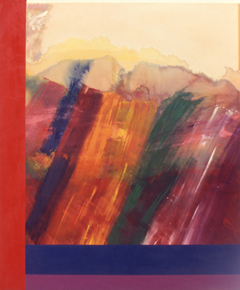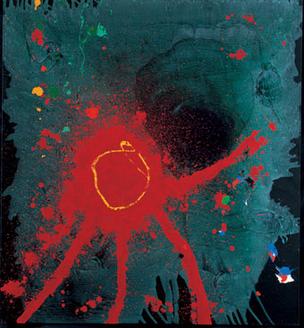Morris Louis Bernstein, known professionally as Morris Louis, was an American painter. During the 1950s he became one of the earliest exponents of Color Field painting. While living in Washington, D.C., Louis, along with Kenneth Noland and other Washington painters, formed an art movement that is known today as the Washington Color School.

Color field painting is a style of abstract painting that emerged in New York City during the 1940s and 1950s. It was inspired by European modernism and closely related to abstract expressionism, while many of its notable early proponents were among the pioneering abstract expressionists. Color field is characterized primarily by large fields of flat, solid color spread across or stained into the canvas creating areas of unbroken surface and a flat picture plane. The movement places less emphasis on gesture, brushstrokes and action in favor of an overall consistency of form and process. In color field painting "color is freed from objective context and becomes the subject in itself."

Ellsworth Kelly was an American painter, sculptor, and printmaker associated with hard-edge painting, Color Field painting and minimalism. His works demonstrate unassuming techniques emphasizing line, color and form, similar to the work of John McLaughlin and Kenneth Noland. Kelly often employed bright colors. He lived and worked in Spencertown, New York.
Mel Bochner is an American conceptual artist. Bochner received his BFA in 1962 and honorary Doctor of Fine Arts in 2005 from the School of Art at Carnegie Mellon University. He lives in New York City.

Ronnie Landfield is an American abstract painter. During his early career from the mid-1960s through the 1970s his paintings were associated with Lyrical Abstraction, and he was represented by the David Whitney Gallery and the André Emmerich Gallery.

Lyrical abstraction is either of two related but distinct trends in Post-war Modernist painting:

Clifford Ross is an American artist who has worked in multiple forms of media, including sculpture, painting, photography and video. His work is in the collections of the Museum of Modern Art, the J. Paul Getty Museum, the Metropolitan Museum of Art, the Whitney Museum of American Art, the Museum of Fine Arts, Houston, and the Philadelphia Museum of Art.

Paul Feeley was an artist and director of the Art Department at Bennington College during the 1950s and early 1960s.

Peter Cain was an artist who is best known for his meticulously executed paintings and drawings of surreal and aberrant versions of automobiles. His style has been said to combine aspects of Surrealism, Photorealism, and the art of James Rosenquist. He is of the same generation of painters who came to prominence in the 1990s such as Elizabeth Peyton, John Currin, Peter Doig, and Karen Kilimnik. He died at age thirty seven of a cerebral hemorrhage having completed sixty-three paintings over the course of his short career. He was represented by the Matthew Marks Gallery in New York during his lifetime.
Matthew Weinstein is a noted and versatile contemporary American visual artist, installation sculptor and film maker.

Abby Leigh is an American artist based in New York City. Her work is held in public collections including the Museum of Modern Art, New York, NY; the Whitney Museum of American Art, New York, NY; the Guggenheim Museum, New York, NY; the Metropolitan Museum of Art, New York, NY; The Hammer Museum, Los Angeles, CA; Houston Museum of Fine Arts, Houston, TX; among others.
David Bradshaw is an American artist based in Cecilia, Louisiana, and East Charleston, Vermont. He is a painter, sculptor, and printmaker. He is married to January Adler.

Stephen Greene was an American artist known for his abstract paintings and in the 1940s his social realist figure paintings.
Carroll Dunham is an American painter. Working since the late 1970s, Dunham's career reached critical renown in the 1980s when he first exhibited with Baskerville + Watson, a decade during which many artists returned to painting. He is known for his conceptual approach to painting and drawing and his interest in exploring the relationship between abstraction and figuration.
David Simpson is an American abstract painter who lives and works in Berkeley, California. In 1956 Simpson graduated from the California School of Fine Arts with a BFA; and in 1958 he earned an MFA, from the San Francisco State College. Since 1958 Simpson has had more than 70 solo exhibitions of his paintings in galleries and museums worldwide. His paintings have been included in hundreds of group exhibitions throughout the United States and Europe. During the early 1960s Simpson was included in two seminal group exhibitions: Americans 1963 at the Museum of Modern Art in New York curated by Dorothy Canning Miller and Post-Painterly Abstraction curated by Clement Greenberg in 1964; that traveled to the Los Angeles County Museum of Art the Walker Art Center and the Art Gallery of Toronto.

Candida Alvarez is an American artist and professor, known for her paintings and drawings.
Accidentalism represents a loosely affiliated art movement related to assemblage, conceptual art and process art during the late 1980s and early 1990s. It is characterized by the interplay and tension between human systems and their physical instantiations often to surprising and humorous outcomes. Artists associated with the movement are Peter Fischli & David Weiss, Greg Colson, Terry Winters, and Tim Hawkinson.
Torkwase Dyson is an interdisciplinary artist based in Brooklyn, New York, United States. Dyson describes the themes of her work as "architecture, infrastructure, environmental justice, and abstract drawing." Her work has been exhibited at the Studio Museum in Harlem, the Whitney Museum of American Art, The Museum of Modern Art, New York, the Corcoran College of Art and Design, and the Smithsonian National Museum of African Art. She is represented by Pace Gallery and Richard Gray Gallery.

Frank Piatek is an American artist, known for abstract, illusionistic paintings of tubular forms and three-dimensional works exploring spirituality, cultural memory and the creative process. Piatek emerged in the mid-1960s, among a group of Chicago artists exploring various types of organic abstraction that shared qualities with the Chicago Imagists; his work, however relies more on suggestion than expressionistic representation. In Art in Chicago 1945-1995, the Museum of Contemporary Art, Chicago (MCA) described Piatek as playing “a crucial role in the development and refinement of abstract painting in Chicago" with carefully rendered, biomorphic compositions that illustrate the dialectical relationship between Chicago's idiosyncratic abstract and figurative styles. Piatek's work has been exhibited at institutions including the Whitney Museum, Art Institute of Chicago, MCA Chicago, National Museum, Szczecin in Poland, and Terra Museum of American Art; it belongs to the public art collections of the Art Institute of Chicago and MCA Chicago, among others. Curator Lynne Warren describes Piatek as "the quintessential Chicago artist—a highly individualistic, introspective outsider" who has developed a "unique and deeply felt world view from an artistically isolated vantage point." Piatek lives and works in Chicago with his wife, painter and SAIC professor Judith Geichman, and has taught at the School of the Art Institute of Chicago since 1974.
Frances Barth is an American visual artist best known for paintings situated between abstraction, landscape and mapping, and in her later career, video and narrative works. She emerged during a period in which contemporary painters sought a way forward beyond 1960s minimalism and conceptualism, producing work that combined modernist formalism, geometric abstraction, referential elements and metaphor. Critic Karen Wilkin wrote, "Barth’s paintings play a variety of spatial languages against each other, from aerial views that suggest mapping, to suggestions of perspectival space, to relentless flatness … [she] questions the very pictorial conventions she deploys, creating ambiguous imagery and equally ambiguous space that seems to shift as we look."












